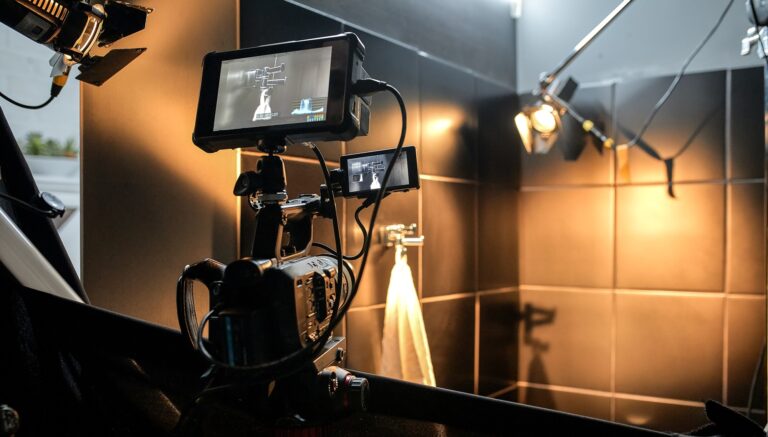“From Storyboard to Screen: The Ultimate Guide to Video Production in 2024” is a comprehensive resource that provides an in-depth look into the future of video production. It covers all aspects of the process, from the initial concept and storyboard creation to the final steps of filming and post-production. This guide is designed to equip readers with the latest techniques, technologies, and trends in the industry, making it an essential tool for both seasoned professionals and those new to the field. With a focus on innovation and efficiency, it offers a glimpse into the future of video production, providing a roadmap for success in the ever-evolving digital landscape of 2024.
Exploring the Evolution of Storyboarding in Video Production 2024
Storyboarding, a critical component of video production, has undergone a significant evolution in recent years, particularly in 2024. This transformation has been driven by technological advancements, changing audience preferences, and the increasing complexity of storytelling in the digital age. The argument here is that these changes have not only enhanced the process of storyboarding but also elevated the quality of video production.
Traditionally, storyboarding involved sketching scenes on paper to visualize the sequence of events in a video. This method, while effective, was time-consuming and lacked flexibility. However, the advent of digital technology has revolutionized this process. Today, digital storyboarding tools allow for easy editing, rearranging, and sharing of storyboards. This has significantly streamlined the process, enabling video producers to create more complex and engaging narratives.
Moreover, the rise of virtual reality (VR) and augmented reality (AR) technologies has added a new dimension to storyboarding. These technologies allow for immersive storyboarding, where producers can visualize scenes in a three-dimensional space. This has not only improved the accuracy of storyboards but also enhanced the creative process, as producers can experiment with different perspectives and angles.
The evolution of storyboarding has also been influenced by changing audience preferences. Today’s audiences demand engaging, high-quality content that tells compelling stories. This has pushed video producers to adopt more sophisticated storyboarding techniques. For instance, the use of color scripts, which involve adding color to storyboards to convey mood and emotion, has become increasingly popular. This technique allows producers to create more emotionally resonant videos that resonate with audiences.
Furthermore, the complexity of storytelling in the digital age has necessitated the evolution of storyboarding. With the proliferation of digital platforms, video producers are now required to create content that works across multiple formats and devices. This has led to the development of multi-platform storyboarding, where producers create different versions of a storyboard for different platforms. This ensures that the video content is optimized for each platform, enhancing its reach and impact.
However, despite these advancements, the essence of storyboarding remains the same. It is still a tool for visualizing the narrative of a video, helping producers to plan and organize their content. What has changed is the way this tool is used, with digital technology enabling more efficient and creative storyboarding processes.
In conclusion, the evolution of storyboarding in 2024 has significantly enhanced the process of video production. The integration of digital technology, the rise of VR and AR, changing audience preferences, and the complexity of storytelling in the digital age have all contributed to this evolution. These changes have not only streamlined the storyboarding process but also elevated the quality of video production, enabling producers to create engaging, high-quality content that resonates with audiences. As we move forward, it is clear that storyboarding will continue to play a crucial role in video production, shaping the way stories are told and experienced.
The Role of Advanced Technology in Video Production: A 2024 Perspective
In the realm of video production, the year 2024 has ushered in a new era of technological advancements that have revolutionized the industry. The role of advanced technology in video production has become increasingly significant, transforming the process from storyboard to screen into a more efficient and creative endeavor. This article will argue that the integration of cutting-edge technology in video production is not only beneficial but also indispensable in the contemporary digital age.
The first point of contention is the use of artificial intelligence (AI) in video production. AI has been instrumental in automating various aspects of the production process, thereby reducing the time and effort required. For instance, AI can be used to automate the editing process, allowing for quicker turnaround times and freeing up human resources for other tasks. Moreover, AI can analyze large amounts of data to predict viewer preferences, enabling producers to create content that is more likely to resonate with their target audience. Therefore, the use of AI in video production is not just a luxury, but a necessity in the fast-paced digital world of 2024.
Secondly, the advent of virtual reality (VR) and augmented reality (AR) technologies has opened up new avenues for storytelling. These technologies allow for immersive experiences that traditional video production methods cannot match. With VR and AR, viewers are not just passive observers but active participants in the narrative. This level of engagement can lead to a deeper emotional connection with the content, making it more memorable and impactful. Hence, the integration of VR and AR technologies in video production is a game-changer, offering unprecedented opportunities for creative storytelling.
Thirdly, the rise of 4K and 8K resolution technologies has significantly improved the quality of video content. These technologies offer a level of detail and clarity that was previously unattainable, enhancing the viewing experience. Furthermore, the widespread adoption of 4K and 8K technologies by consumers has made it imperative for video producers to keep up with the trend. Failing to do so could result in content that appears outdated and unappealing, potentially leading to a loss of viewership. Thus, the use of high-resolution technologies is crucial in maintaining a competitive edge in the video production industry.
Lastly, the proliferation of cloud-based platforms has revolutionized the way video content is stored and shared. These platforms offer a secure and efficient means of storing large amounts of video data, making it easily accessible to team members regardless of their location. This facilitates collaboration and speeds up the production process. Additionally, cloud-based platforms enable seamless sharing of video content with viewers, making it easier to reach a wider audience. Therefore, the use of cloud technology is integral to the efficient and effective production and distribution of video content.
In conclusion, the role of advanced technology in video production is undeniable. From AI to VR and AR, 4K and 8K resolution technologies, and cloud-based platforms, these advancements have transformed the process from storyboard to screen, making it more efficient, creative, and impactful. As we navigate through 2024 and beyond, it is clear that the integration of cutting-edge technology in video production is not just beneficial, but essential in staying relevant in the ever-evolving digital landscape.
The Ultimate Guide to Screenwriting for Video Production in 2024

In the realm of video production, the journey from storyboard to screen is a complex and intricate process. As we delve into the year 2024, the landscape of this industry continues to evolve, with screenwriting playing a pivotal role in shaping the final product. This article aims to provide an ultimate guide to screenwriting for video production in 2024, arguing that a well-crafted script is the cornerstone of any successful video project.
Screenwriting, at its core, is the art of visual storytelling. It is the blueprint that guides the entire production process, from pre-production planning to post-production editing. In the digital age, the importance of a well-structured, engaging script cannot be overstated. It is the foundation upon which the director, actors, and production crew build their work. Without a strong script, even the most visually stunning video can fall flat.
In 2024, the screenwriting process has become more dynamic and collaborative than ever before. With the advent of advanced technology and software, screenwriters now have the tools to create more immersive and interactive scripts. These technological advancements have not only streamlined the writing process but also allowed for greater creative freedom. However, despite these changes, the fundamental principles of screenwriting remain the same. A compelling narrative, well-developed characters, and engaging dialogue are still the hallmarks of a great script.
One of the key trends in 2024’s screenwriting landscape is the increasing emphasis on diversity and representation. As audiences become more diverse, there is a growing demand for stories that reflect this diversity. Screenwriters are now tasked with creating scripts that represent a wide range of experiences and perspectives. This shift towards inclusivity not only enriches the storytelling process but also broadens the appeal of the final product.
Another significant trend is the rise of short-form content. With the proliferation of social media and streaming platforms, audiences are consuming more short-form videos than ever before. This has led to a shift in screenwriting techniques, with writers now focusing on creating concise, impactful scripts that can engage audiences in a shorter timeframe. This trend underscores the importance of mastering the art of brevity in screenwriting.
Despite these evolving trends, the essence of screenwriting remains rooted in the art of storytelling. The ability to craft a compelling narrative, create engaging characters, and write sharp dialogue is still paramount. In 2024, the most successful screenwriters are those who can adapt to the changing landscape while staying true to these fundamental principles.
In conclusion, the journey from storyboard to screen is a complex process that hinges on the strength of the script. As we navigate the landscape of video production in 2024, it is clear that a well-crafted script is more important than ever. From embracing diversity to mastering the art of brevity, screenwriters must adapt to the evolving trends while staying true to the core principles of storytelling. As the ultimate guide to screenwriting for video production in 2024, this article argues that a strong script is the cornerstone of any successful video project.
Understanding the Transition from Storyboard to Screen in 2024
In the realm of video production, the transition from storyboard to screen is a critical process that requires meticulous planning, creativity, and technical expertise. As we delve into the year 2024, the landscape of video production has evolved significantly, with advancements in technology and innovative storytelling techniques shaping the way we bring ideas to life on screen.
The storyboard, a visual representation of the video’s narrative, serves as the blueprint for the entire production process. It is here that the director’s vision is first articulated, with sketches and notes detailing everything from camera angles to character movements. However, the journey from storyboard to screen is not a simple one-to-one translation. It is a complex, iterative process that involves a series of creative decisions and technical executions.
In 2024, the advent of virtual reality (VR) and augmented reality (AR) technologies has revolutionized the storyboard-to-screen transition. Directors and cinematographers can now visualize their storyboards in a three-dimensional space, allowing for a more immersive and accurate representation of the final product. This not only enhances the creative process but also streamlines communication among the production team, reducing the likelihood of misunderstandings and costly mistakes.
Moreover, the rise of artificial intelligence (AI) in video production has further streamlined the transition process. AI-powered software can now automate certain aspects of the production process, such as editing and color grading, saving valuable time and resources. These technologies can analyze the storyboard and generate a rough cut of the video, providing a tangible starting point for the director and editor.
However, while these technological advancements have undoubtedly made the transition from storyboard to screen more efficient, they have not diminished the importance of human creativity and intuition. The director’s vision, the cinematographer’s eye, and the editor’s skill are still paramount in crafting a compelling narrative. Technology is merely a tool that aids in the realization of this vision, not a replacement for the creative process.
In fact, the increasing complexity of video production in 2024 has underscored the importance of a well-crafted storyboard. With more tools and techniques at their disposal, filmmakers must be even more meticulous in planning their shots and sequences. A detailed storyboard not only guides the production process but also serves as a reference point, ensuring that the final product remains true to the original vision.
Furthermore, the transition from storyboard to screen is not just about technical execution; it’s also about storytelling. The most successful videos are those that tell a compelling story, and this starts with the storyboard. The way a scene is framed, the pacing of the dialogue, the timing of the cuts – these are all storytelling decisions that are made during the storyboard stage and executed during production.
In conclusion, the transition from storyboard to screen in 2024 is a multifaceted process that combines technological innovation with creative storytelling. While advancements in VR, AR, and AI have made the process more efficient, the importance of a well-crafted storyboard and human creativity cannot be overstated. As we continue to push the boundaries of what is possible in video production, the storyboard remains the foundation upon which all successful videos are built.
The Future of Video Production: From Storyboard to Screen in 2024
As we look towards the future of video production, it is clear that the journey from storyboard to screen will continue to evolve and transform in 2024. The advent of new technologies, the rise of digital platforms, and the changing preferences of audiences worldwide are all contributing to a dynamic shift in the way videos are produced and consumed.
The first step in the video production process, the storyboard, is undergoing a significant transformation. Traditionally, storyboards have been hand-drawn illustrations that map out the sequence of a video. However, with the rise of virtual reality (VR) and augmented reality (AR) technologies, storyboarding is becoming an immersive, interactive experience. Filmmakers can now create 3D storyboards that allow them to visualize scenes from different angles, experiment with lighting and camera movements, and even simulate actor performances. This not only enhances the creative process but also improves efficiency by identifying potential issues before the actual filming begins.
The filming process itself is also being revolutionized by technology. Drones and robotic cameras are enabling filmmakers to capture shots that were previously impossible or prohibitively expensive. Artificial intelligence (AI) is being used to automate tasks such as color grading and sound editing, freeing up filmmakers to focus on the creative aspects of video production. Moreover, the rise of 8K resolution cameras is pushing the boundaries of visual quality, providing viewers with an unprecedented level of detail and realism.
The post-production stage is perhaps where the most significant changes are taking place. Advanced software is making it easier than ever to edit footage, add special effects, and synchronize sound. Cloud-based platforms are facilitating collaboration among team members, regardless of their physical location. Furthermore, AI is being used to automate tedious tasks such as transcribing dialogue and tagging footage, significantly speeding up the post-production process.
The way videos are distributed and consumed is also changing dramatically. The rise of streaming platforms like Netflix and Amazon Prime has disrupted traditional distribution channels, giving filmmakers direct access to global audiences. Social media platforms such as YouTube and TikTok are providing new avenues for video content, catering to the growing demand for short, engaging videos. Moreover, the advent of 5G technology is set to revolutionize video streaming, offering faster speeds and lower latency, which will enhance the viewing experience.
However, while technology is undoubtedly driving the future of video production, it is essential not to lose sight of the human element. Storytelling remains at the heart of video production, and no amount of technology can replace a compelling narrative and engaging characters. Filmmakers must therefore strike a balance between leveraging new technologies and maintaining the artistry and craft that make videos resonate with audiences.
In conclusion, the future of video production in 2024 promises to be an exciting blend of technological innovation and creative storytelling. From immersive storyboarding to AI-assisted post-production, filmmakers will have a wealth of tools at their disposal to bring their visions to life. However, amidst these changes, the fundamental principles of filmmaking – storytelling, creativity, and emotional resonance – will remain as vital as ever. As we move from storyboard to screen in 2024, it is these principles that will continue to guide the evolution of video production.
Innovative Techniques in Video Production: A 2024 Guide from Storyboard to Screen
In the ever-evolving world of video production, the journey from storyboard to screen has become increasingly complex and innovative. As we delve into the year 2024, the industry is brimming with cutting-edge techniques that are revolutionizing the way we create and consume visual content. This article aims to guide you through the most innovative techniques in video production, providing a comprehensive overview of the process from storyboard to screen.
Firstly, the advent of virtual reality (VR) and augmented reality (AR) technologies has significantly transformed the video production landscape. These technologies allow filmmakers to create immersive experiences that transport viewers into the heart of the story. VR and AR have moved beyond being mere gimmicks, becoming integral parts of the storytelling process. They offer a new dimension of engagement, enabling audiences to interact with the narrative in ways that were previously unimaginable.
Transitioning from the virtual to the physical, drone technology has also made a significant impact on video production. Drones provide filmmakers with the ability to capture stunning aerial shots and unique perspectives that were once only possible with expensive helicopter rentals. This technology has democratized aerial cinematography, making it accessible to filmmakers of all budgets and skill levels.
Moreover, the rise of artificial intelligence (AI) in video production cannot be overlooked. AI has the potential to automate various aspects of the production process, from scriptwriting to editing. For instance, AI algorithms can analyze vast amounts of data to predict viewer preferences, enabling filmmakers to create content that resonates with their target audience. Furthermore, AI can streamline the editing process by automatically identifying and compiling the best shots. This not only saves time but also ensures a high level of precision and consistency.
In addition to these technological advancements, there has been a shift towards more sustainable practices in video production. Filmmakers are increasingly recognizing the environmental impact of their work and are adopting eco-friendly techniques to mitigate this. This includes using renewable energy sources to power sets, implementing waste management strategies, and opting for digital methods over traditional, resource-intensive processes.
However, despite these advancements, the importance of a well-crafted storyboard remains paramount. The storyboard is the blueprint of the video, outlining the sequence of scenes, camera angles, and dialogue. It serves as a visual guide for the entire production team, ensuring everyone is on the same page. With the advent of digital storyboarding tools, this process has become more efficient and collaborative, allowing for real-time updates and adjustments.
In conclusion, the journey from storyboard to screen in 2024 is characterized by a blend of innovative technologies and traditional techniques. From VR and AR to drones and AI, these advancements are pushing the boundaries of what is possible in video production. However, amidst this technological revolution, the importance of a well-crafted storyboard remains unchanged. It serves as the foundation upon which these innovative techniques are built, guiding the production process from start to finish. As we move forward, it will be exciting to see how these trends continue to evolve and shape the future of video production.
Mastering the Art of Video Production: From Storyboard to Screen in 2024
In the ever-evolving world of digital media, mastering the art of video production has become an essential skill. As we navigate through 2024, the journey from storyboard to screen has become more complex and nuanced, demanding a comprehensive understanding of the process. This article aims to provide an ultimate guide to video production in 2024, arguing that a well-executed video production process is a critical component of successful digital storytelling.
The first step in the video production process is the creation of a storyboard. This is a visual representation of your video, outlining each scene, the dialogue, and the actions that will take place. It serves as a blueprint for the entire production process, ensuring that everyone involved understands the vision and direction of the project. In 2024, storyboarding has evolved beyond simple sketches and now often involves digital tools and software that allow for more detailed and dynamic representations. This advancement has made the process more efficient and precise, allowing for a more seamless transition from concept to execution.
Once the storyboard is complete, the next step is pre-production. This involves planning every detail of the video, from location scouting to casting to scheduling. In 2024, pre-production has become more critical than ever, as the increasing complexity of video projects requires meticulous planning and organization. The use of project management tools and software has become commonplace, enabling teams to coordinate tasks and timelines more effectively. This ensures that the production process runs smoothly and that the final product aligns with the initial vision outlined in the storyboard.
The production phase is where the storyboard comes to life. This involves filming the scenes as outlined in the storyboard, with the director guiding the actors and crew to capture the desired shots. In 2024, the production phase has seen significant advancements in technology, with high-quality cameras and equipment becoming more accessible and affordable. This has allowed for more creative freedom and experimentation, resulting in more dynamic and engaging videos.
Post-production is the final step in the video production process. This involves editing the footage, adding special effects, and fine-tuning the audio. In 2024, post-production has become more sophisticated, with advanced software allowing for more precise editing and effects. This has elevated the quality of videos, making them more immersive and captivating for viewers.
In conclusion, the journey from storyboard to screen in 2024 is a complex process that requires a deep understanding of each phase of video production. From the initial storyboard creation to the final post-production edits, each step is critical in bringing the vision to life. The advancements in technology and software have made the process more efficient and precise, allowing for more creative freedom and higher quality videos. However, it’s important to remember that at the heart of any successful video production is a compelling story. Regardless of the tools and technology used, the ultimate goal is to engage and captivate the audience through effective storytelling. Therefore, mastering the art of video production in 2024 is not just about understanding the technical aspects, but also about honing the craft of storytelling.
Conclusion
The Ultimate Guide to Video Production in 2024 provides a comprehensive overview of the process from storyboard to screen, highlighting the importance of planning, creativity, and technical skills. It emphasizes the advancements in technology and the increasing accessibility of high-quality equipment and software. The guide also underscores the significance of storytelling and audience engagement in successful video production.





